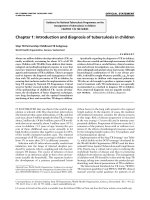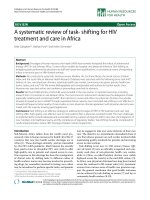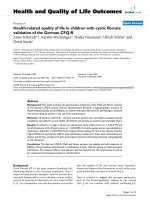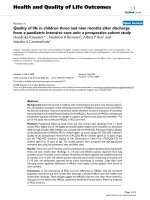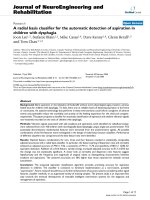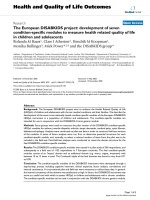Efficacy of buccal midazolam for emergency treatment of seizures in children
Bạn đang xem bản rút gọn của tài liệu. Xem và tải ngay bản đầy đủ của tài liệu tại đây (541.72 KB, 25 trang )
Efficacy of buccal
midazolam for emergency
treatment of seizures in
children
Dr Nguyen Hoang Phuong Anh
General
• Tonic-clonic seizures: common problem in
children
• A drug: easy to give, effective, and safe,
and would have a long-lasting antiseizure
action
• Rectal diazepam and buccal midazolam
are used for emergency treatment
• Intravenous access is not always possible
No intravenous
• Rectal diazepam
• Intranasalmidazolam
• Buccal midazolam
Rectal diazepam
• Rapid initial response in 60–80%
• Risk of early recurrence of seizures:
30%
• Difficult to arrange in schools and respite
care facilities or other out-of-hospital
environments, and absorption is
variable
Intranasal midazolam
• Effective, but it can be less reliable in the
presence of concurrent upper respiratory
tract infection.
2005 July,UK
• Safety and efficacy of buccal midazolam
versus rectal diazepam for emergency
treatment of seizures in children
Methods
• Multicentre, randomised controlled trial
• Children aged ≥ 6 months presenting to
hospital with active seizures and without
intravenous access
• Children who had chronic epilepsy or given
prehospital emergency or rescue treatment
were not excluded from the trial
• Most seizures would be generalised
tonicclonic
Buccal midazolam
Dose
• Buccal midazolam or rectal diazepam:
0.5mg/kg
2.5mg for 6–12months
5mg for 1–4years,
7.5mg for 5–9years
10mg ≥ 10years
Evaluation parameters
•
•
•
•
Therapeutic success
Time (mins) to stop seizing
Given intravenous lorazepam
Respiratory depression
Therapeutic success
• Cessation of visible signs of seizure
activity within 10 min
• Without another seizure within the hour.
• Without respiratory depression
Results
• From October, 2000, to February, 2004, in
the four participating hospitals: 219
separate episodes involving 177 patients
• 110 rectal diazepam treatment episodes
• 109 buccal midazolam treatment episodes
Characteristics
of the sample
2 study groups
did not differ
Buccal midazolam
• Therapeutic success more rectal
diazepam
• Stopped seizures within 10min in more
children
• Does not appear to increase the risk
of respiratory depression
• Few have given intravenous lorazepam
2008 Jan, Uganda
• Single-blind, randomized clinical trial in
which 330 patients
• 3 months to 12 years
• Cessation of seizures within 10mins,
without recurrence in 1hr.
Results
• 114 (69.1%) seizures terminated within 10
minutes in the diazepam arm compared
with 125 (75.8%) in the midazolam arm
• No statistical difference in malaria-related
seizure.
• For children without malaria, buccal
midazolam was superior (d=55.9% vs
m=26.5%) (P=.002)
Safety
• Only 4 (1.2%) children experienced
respiratory depression. These patients
included 2 in the diazepam group and 2
patients in the buccal midazolam arm
Conclusion
• Buccal midazolam recommended
alongside rectal diazepam as the first-line
treatment for prolonged seizure in children
• More effective than rectal diazepam for
treatment of children with seizures in a
hospital emergency department
References
1. John McIntyre, Safety and efficacy of buccal midazolam versus
rectal diazepam for emergency treatment of seizures in
children: a randomised controlled trial, Thelancet, vol 366,
Luly 16, 2005.
2. Knudsen FU. Rectal administration of diazepam in solution in
the acute treatment of convulsions in infants and children. Arch
Dis Child 1979; 54: 855–57.
3. Dieckmann RA. Rectal diazepam for prehospital pediatric status
epilepticus. Ann Emerg Med 1994; 23: 216–24.
THANK YOU

